Victoria Amplifiers no longer Naperville’s secret
Mark Baier is sitting in his warehouse in an industrial park on the far west side of Naperville, Ill. He picks up a Stratocaster and starts to play the Beatles hit “I Feel Fine.”
And why shouldn’t Baier feel fine?
The warm tones on a cold February afternoon are impeccable through his Victoria Amplifier. Baier created and designed the Victoria, the amplifier of choice for Bob Dylan, Keith Richards, Eric Clapton, Buddy Guy, John Legend, John Mayer, and many more. Mayer made the effort to find the Victoria Amplifier Company, lost in a shuffle of nondescript industries like Conley Steel and MidWest Stair Parts near the border of west suburban Naperville. and Aurora.
Victoria’s business was thriving, even during the February pandemic. Baier maneuvered around Victoria boxes ready to be shipped. “Everything we do is to order,” he said from under a dapper black fedora. “We’re back-ordered over 80 amps right now. This pandemic has been a scourge on the live music industry and everything, but our business is busting balls. People aren’t spending money on trips or whatever they’d be doing. So rich people are buying amps. While my professional class is struggling, my rich person class is doing pretty good.”
He has custom-made amps for Billy Gibbons of ZZ Top. “We had a harmonica player order an amp with nine eight-inch speakers,” Baier said. “That’s a lot of speakers in one amp. I don’t like to modify this stuff too much. I want to build amplifiers I would want to buy.”
It’s been a long strange trip for Baier. He was born on the south side of Chicago where his father Dave obtained an MBA from the University of Chicago. “While the ink was still wet on the diploma he was looking for houses in Naperville,” said Baier, who is 60.
As a kid, Baier took coronet lessons at the late great Gil Ellman’s music store in downtown Naperville. He became an avid guitar player who performed in bands until his early 20s. Baier quit playing, took on several jobs, and became a stockbroker in 1990. “I quit working downtown in 1997,” he said. “I took up the guitar again. And for the first time in my life, I had money to buy a new guitar. I bought a Stratocaster. I had never bought a new guitar. I always bought used ones–despite growing up in Naperville.”
Dave Baier was an information tech at Ryerson Steel in Chicago. His wife Jane was a school administrator for District 204 in Naperville. Dave and Jane are deceased.
“I live in the house we were in when I went to (Naperville Central) high school,” Baier said. “From the moment my mother woke up until she went to bed, she would have WGN radio on. I may have a little better vocabulary than people my age because all I did was listen to the radio. Even in the womb, I was listening to Wally Phillips. I fell in love with the Beatles. By the time I was seven years old, the entire culture was centered around the Beatles. I wanted to play guitar. My father fought it. He wanted me to be an MBA like him, or get a science degree.”
Baier did play guitar in the Naperville Central jazz band. “That was the only way I could get my Dad to let me have an electric guitar,” he said. Baier still plays guitar to test every amplifier. He also plays guitar and sings background vocals in the R&Bs, a gritty western suburban band that sounds like a hybrid of the Faces and Georgia Satellites. Their self-released 2014 CD includes saucy blues-rock tunes like “Tilt-A-Whirl,” “Pimpin” and “Piston of Love.”
The pivot point in Baier’s career was when he bought a reissued Fender Bassman amp to accompany his new guitar. “It sounded terrible,” he said. Baier turned to his used 1960 Fender Bassman. It sounded better. “ I was surprised that when I took the back panel off the new one, it was like a computer inside,” he said. “Grand circuit board, tiny components. I opened up the old one. The biggest difference was the parts quality and construction methods. So I was going to learn about guitar amps.”
Baier went to Nichols Library in downtown Naperville and checked out dozens of beginner’s electronic books that were published before 1960. He did less research on the late Leo Fender, who invented the Bassman, the Telecaster, and more. “All I wanted to know was resistors, capacitors, and tubes,” he said. “Basic electronics. Not surprisingly, the most effective books were training books for military personnel.
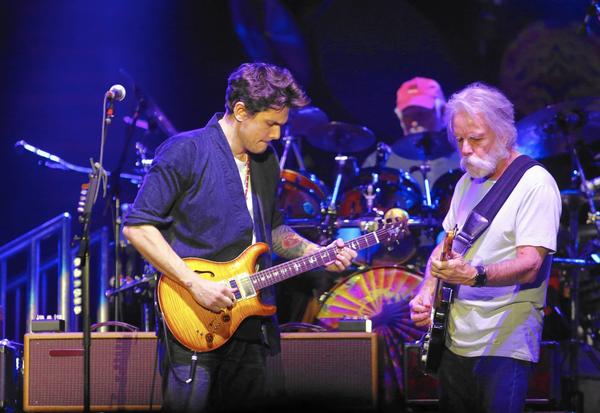
Image courtesy of Victoria Amplifiers
“I wasn’t going to be happy with building anything less than the exact copy of the Bassman. I had to buy the parts. I sourced the wire manufacturer out of Massachusetts. The carbon resistors had to be Allen Bradley. I ended up buying over $200,000 worth of resistors. That’s what stockbroker money will do you. By the time I had purchased the components needed to build one amp, I had enough components to build 50 amps.”
While still a stockbroker, Baier began building the amps on the ping-pong table of his Naperville home that he shared with his former wife Maureen. (They remain business partners.) They moved the company into their 3,200 square-foot warehouse in 1996. Victoria is on pace to turn out between 350 and 400 units in 2021. Baier started his serial numbers at one and his company had hit number 7,923 in mid-February.
Baier officially founded the Victoria Amplifier Company in 1994. He named the company after his daughter. “It infers classic American electronics,” he said. “RCA Victor. Victrola.” The Victoria logo was designed by John Casado, who has done album covers for the Doobie Brothers, Carole King and the logotype for the Band and the “Last Waltz” film. Daughter Victoria, 27, is married and works for Amazon in Seattle. His other daughter, Maggie, 29, is a Chicago Public Schools high school teacher.
While obtaining a degree in geology at the University of Iowa, Baier played guitar in a blues-rock band called The Knock (like in rock.) “I saw Muddy Waters there and I got to know Bob Margolin, his guitar player,” Baier said. “Bob was a columnist for the Blues Review Quarterly. So I called up Bob, reminded him who I was from Iowa, and told him I had built this guitar amp.” Margolin said he would review the amplifier for his publication. Margolin gave the tweed super a five-star review.
“The next thing I know the phone is ringing and I sold 20 amps,” he said. “The Chicago blues community saw it. I was approached by the people who were managing Buddy Guy in early ‘96. He bought two amps and I’d put two amps in his club. I met Luther Allison, Otis Rush, Junior Wells. They’d all come to his club and play through the amps. It just took off.”
Acclaimed Chicago guitarist Dave Specter was Baier’s first “name” client. He saw an ad for Victoria in a blues magazine and noticed the company was in the Chicago area. “We started talking and Mark actually gave me one of his Bassman’s,” Specter said in a phone conversation. “And Mark is so great to talk to. He’s like the ‘Professor of Amps’.” Specter uses the Golden Melody, Golden Specialty, and Tweed deluxe. One Victoria lives in the Evanston live music club SPACE, of which Specter is a partner.
“People who come through the club love the Victoria,” Specter said. “I consider myself a blues-based guitarist with influences from jazz to funk to soul and rock and roll. They sound great for all styles of music. The tone qualities combine Fender Bassman and vintage Gibson amp sounds. I’ve become a more aggressive player. I play harder and they break up with a bit more distortion and crunch. That’s come through loud and clear with my last couple albums I recorded with Victorias.”
Keith Richards, Ron Wood and Eric Clapton bought their Victorias through Baier’s dealer in London, England. A black and white photo of Bob Dylan hangs in the company workshop.
“Dylan has been an amazing patron,” Baier said. “He’s bought seven amps. One of the first uses of my Reverberammo (with vibrato circuit) unit is on (Dylan’s 1997 Grammy-winning) ‘Time out of Mind.’ Early on, my dealer in New York was Rudy’s Music. I’ve never spoken with Bob, but Dylan’s gear guy called me and said he liked the Bassman at Rudy’s and how they were perfect for Bob. He ordered two of those. Then ten years later he saw my Golden Melody amp. He ended buying four of those.”
The Golden Melody is Baier’s triple-crown masterpiece.
“In the case of Bob loving that amp, that represents our most fully realized amp,” Baier said. “The high water mark for vacuum tube design was the late 1950s. Anything after that they were looking at solid state. Vacuum tubes have a more natural, richer more pleasant tone than solid state. It’s especially important with guitar amplifiers, because with the guitar amp you’re producing a sound. You’re not reproducing a sound. The Golden Melody combines the best aspects of the three major Fender amp periods. Tweed (covered in cloth used for luggage) amp, the foundation is the Bassman (the bass guitar prototype for tube amps). The Blackface, the contribution is a brighter reverb. And the Brown amps, their main contribution to the guitar community is the tremelo. I put it all in one amp. What did Bob Dylan hear? He heard 60 years of guitar amps all put into one amp.” The Golden Melody retails for $2,999.
Specter added, “Bob Mould (Husker Du) played my Golden Melody at a solo show at SPACE. It was possibly the loudest show I had ever heard in that club. It was a monstrous guitar sound you could hear a half a block away James Hunter loves the Golden Melody at SPACE.”
Baier explained, “In the late 1950s the Fender amp had to be able to amplify anything that needed to be louder, whether it was a guitar, a bass, an accordion. The amplifier had to have the bandwidth (bass to treble) and fidelity to amplify everything accurately. The downside was that with all this bandwidth, you can’t outrun basic electronics which says the longer a frequency, the earlier it will go into clipping (distortion.) This is what makes Tweed amps popular with people who want an overdriven sound. It is easier to drive them into clipping. Back in 1960, that’s not what they were looking for. They were looking for clean volume. Fender decided to make an amp geared specifically to guitar and that culminated in the Blackface amps. The Golden Melody wasn’t an amp I could have made right off the bat. I needed to build a few thousand amps before it came together.”
On this winter afternoon in the Victoria workshop, classical music from Chicago’s WFMT-FM is playing through a speaker that came out of the defunct 914 Sound Studio in Blauvet, N.Y. where Bruce Springsteen recorded “Born to Run.” “I listen to rock, but this is just more pleasant,” Baier said. “This speaker was the industry standard for recording studios for years. This is a speaker that Capitol Records would buy directly from Altec. (Altec Lansing provided the sound system for Woodstock.) It probably is the most neutral, prettiest sounding speaker you can imagine. Instead of the horn on the top, the horn goes right through the center of the woofer. Listen! It’s brilliant.”
A large box of soul and rock CDs is in front of the historic speaker. When listening to the CDs, does Baier think of someone he would like to build an amp for? “Wow, a wish list, that’s a good one,” he says. Baier stops and thinks for a long time. Later when talking about Robert Plant, he said, “Okay, Jimmy Page! And I’ll throw Bill Frisell in there.” Baier also keeps his chops sharp by contributing reviews to Linda Cain’s Chicago Blues Guide.
Baier’s staff consists only of Maureen and JoAnne Klein. Klein likes to send texts under the name of Lilly Garland. The real Lilly Garland was an assembly woman for Fender during the 1950s. “Lilly was notorious for leaving her name in masking tape on countless 1950s chassis indicating that she built it,” Baier explained. “The tweed amps were all made by women who left their name on the masking tape in the chassis. Lilly and Lupe are the most common of the ‘50s chassis gals.”
Klein-Garland was soldering on the Golden Melody board as Baier strolled by. The board goes into the chassis. “This is one of the few models we build on fiberglass,” he said. “It’s a model we initially designed and built for Fender. When our contract with Fender expired in 2008–along with the economy—we just carried on building these amps.
“Everything has a place. Before you put them together you have to put A before B. This could be a sweatshop in Fullerton, California (the site of the original Leo Fender factory) circa 1955.” And all Victor Amplifiers contain American parts. The chassis is made in Addison, Ill., and transformers are manufactured in McHenry, Ill.”
Baier has thought about leaving Naperville. “It would have been good to be closer to where the action is,” he said. “I looked on the north side of Chicago. I’m paying six bucks a square foot here. They wanted like 14 bucks a square foot. I’d have to commute from Naperville. It was the past of least resistance to stay here.”
Everything does have a place. Mark Baier’s place is in Naperville.

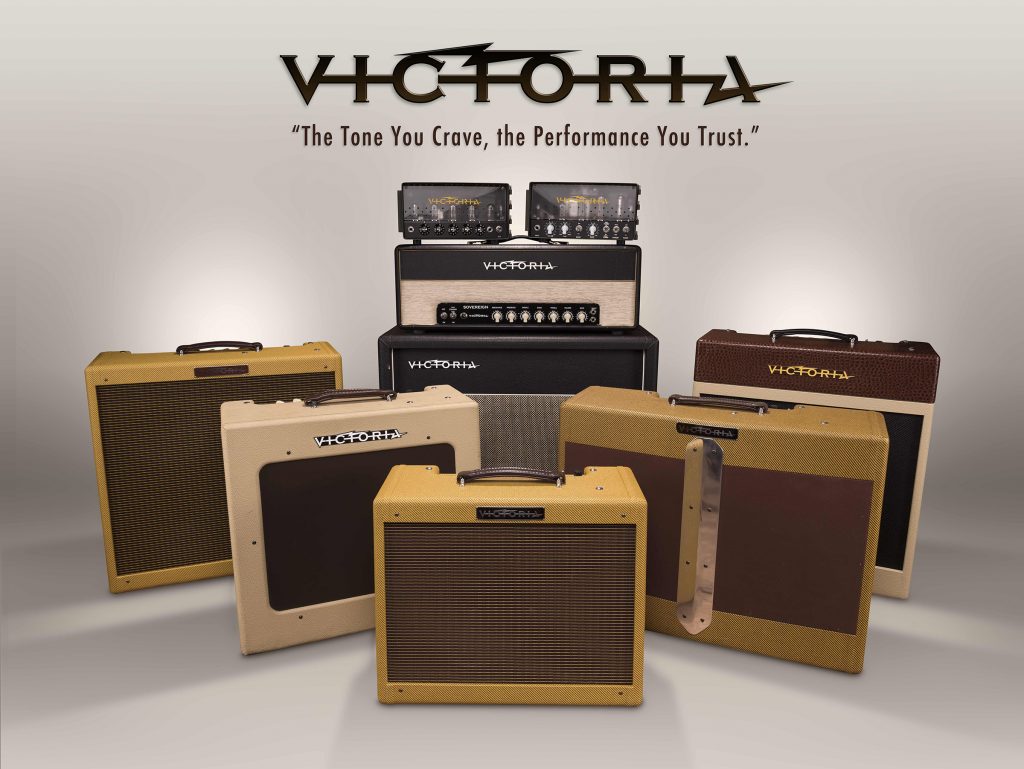
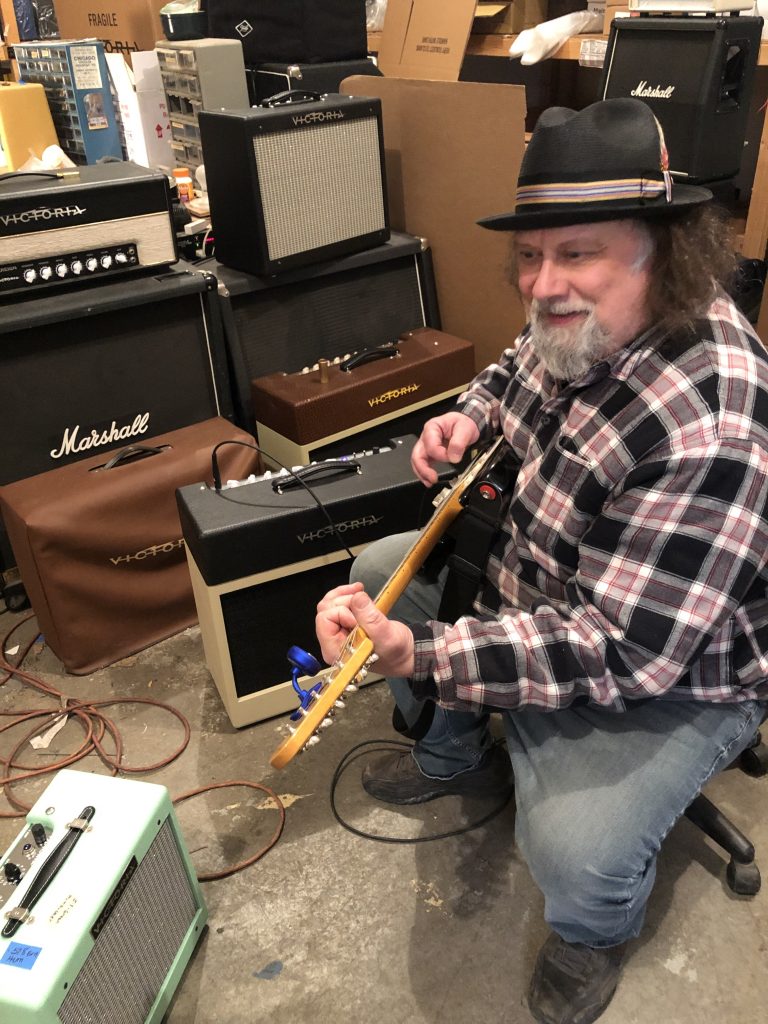
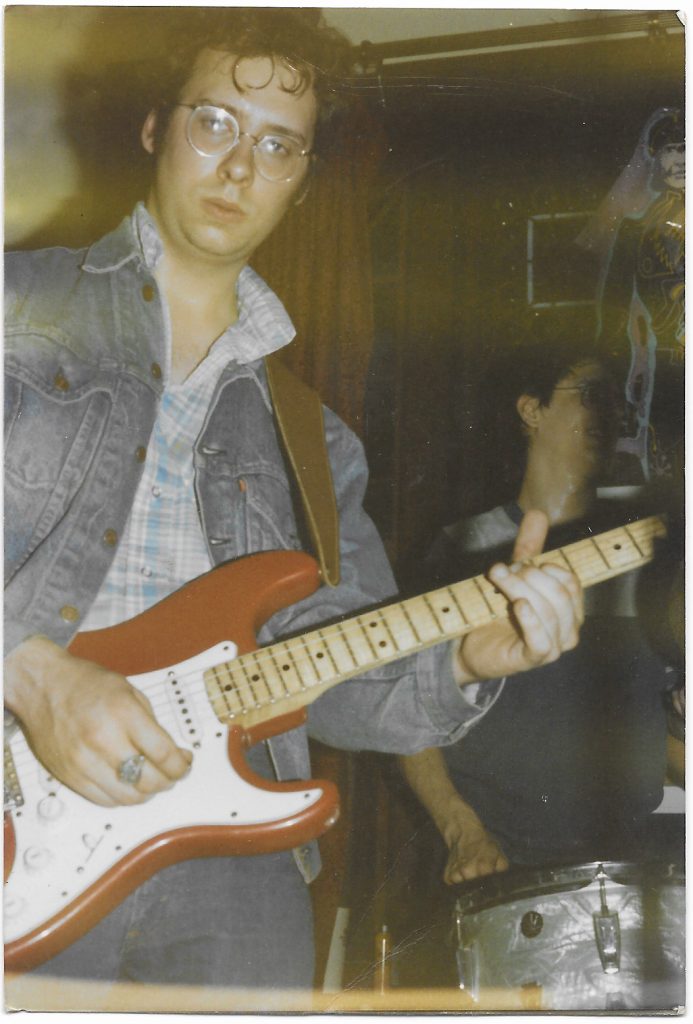
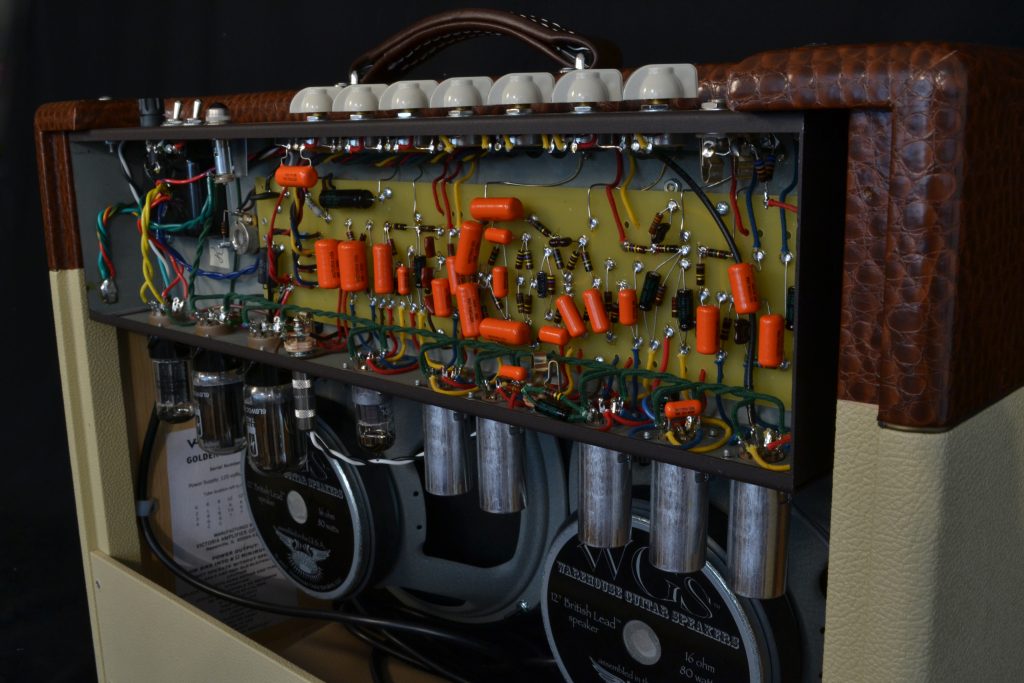
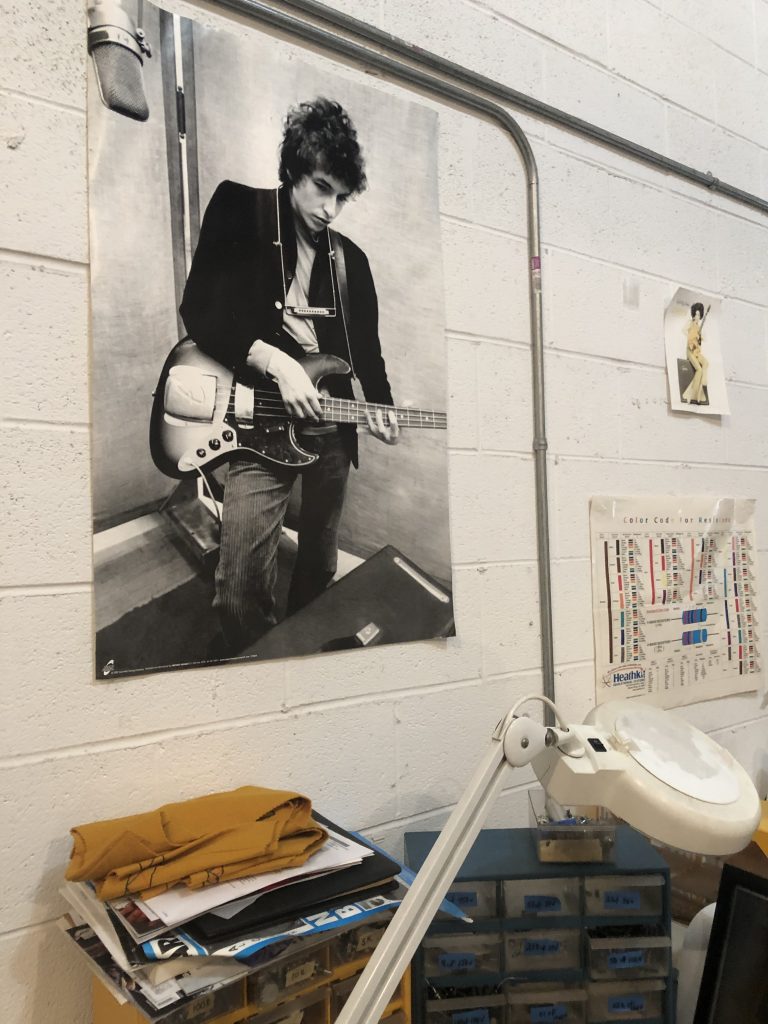
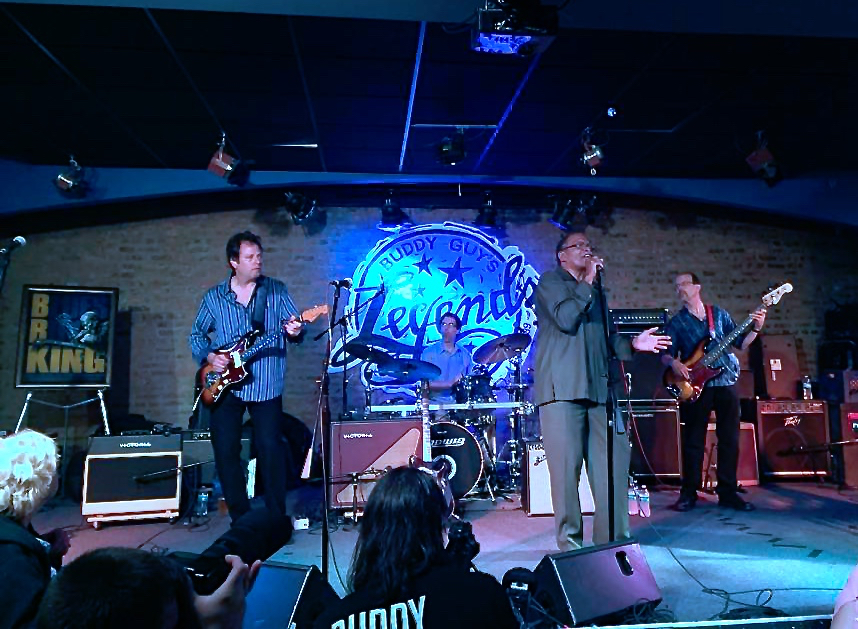
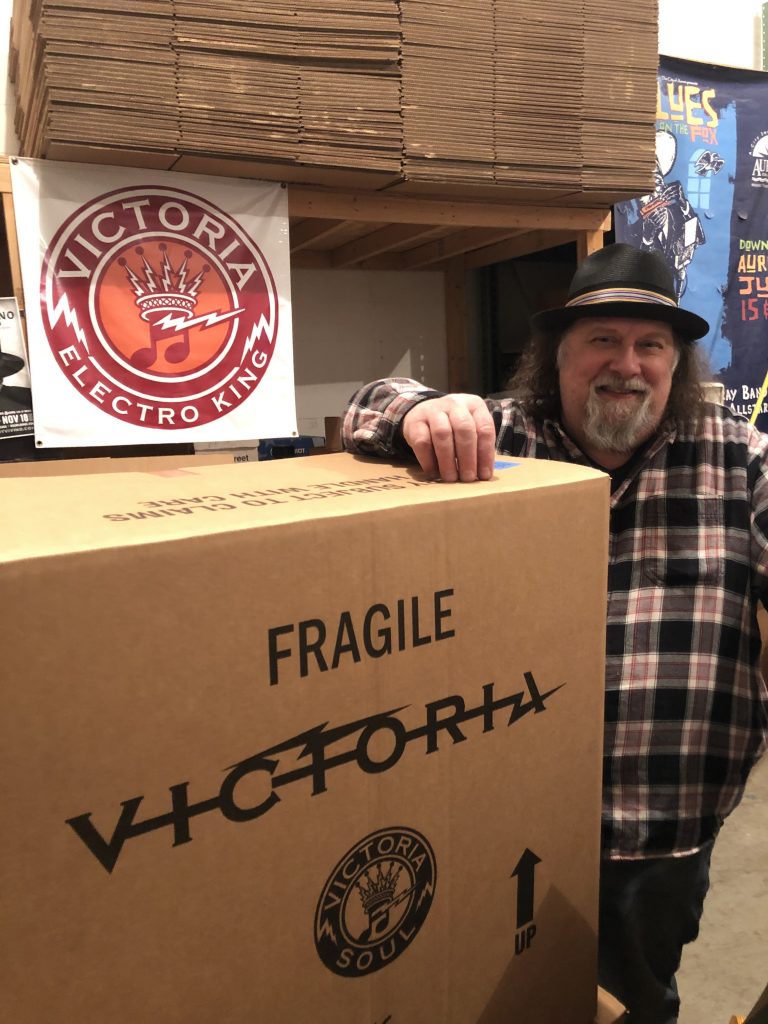
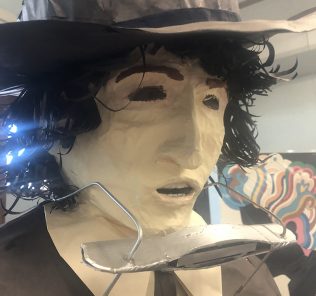


What a great story. Thank you
Thanks, Winnie!
Victoria amps are incredible. Finally captured the tone I always heard in my head. Great article.
Thank you for writing and reading, Dave
Great story, what a gem.
Thanks, pal!
Love this story about Mark Baier and Victoria Amps! (Love the amps, too, particularly the Vicky Verb.) Thanks for writing this, Dave. And keep on rocking and building, Mark. We old guys (we’re the same age) need to stay in the game!
Thanks for checking in, Greg! Stay in touch, Old Dave